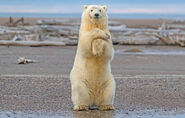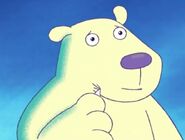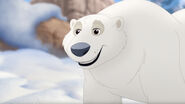
A polar bear in Alaska
Polar bears roam the Arctic ice sheets and swim in that region's coastal waters. They are very strong swimmers, and their large front paws, which they use to paddle, are slightly webbed. Some polar bears have been seen swimming hundreds of miles from land—though they probably cover most of that distance by floating on sheets of ice. A boar (adult male) weighs around 350–700 kg (772–1,543 lb), while a sow (adult female) is about half that size. Although it is the sister species of the brown bear, it has evolved to occupy a narrower ecological niche, with many body characteristics adapted for cold temperatures, for moving across snow, ice, and open water, and for hunting seals, which make up most of its diet. Although most polar bears are born on land, they spend most of their time on the sea ice. Their scientific name means "maritime bear", and derives from this fact. Polar bears hunt their preferred food of seals from the edge of sea ice, often living off fat reserves when no sea ice is present. Because of their dependence on the sea ice, polar bears are classified as marine mammals.
Arctic Adaptations
Polar bears live in one of the planet's coldest environments and depend on a thick coat of insulated fur, which covers a warming layer of fat. Fur even grows on the bottom of their paws, which protects against cold surfaces and provides a good grip on ice. The bear's stark white coat provides camouflage in surrounding snow and ice. But under their fur, polar bears have black skin—the better to soak in the sun's warming rays.
Hunting
These powerful predators typically prey on seals. In search of this quarry they frequent areas of shifting, cracking ice where seals may surface to breathe air. They also stalk ice edges and breathing holes. If the opportunity presents itself, polar bears will also consume carcasses, such as those of dead whales. These Arctic giants are the masters of their environment and have no natural enemies.
Breeding and Behavior
Females den by digging into deep snow drifts, which provide protection and insulation from the Arctic elements. They give birth in winter, usually to twins. Young cubs live with their mothers for some 28 months to learn the survival skills of the far north. Females aggressively protect their young, but receive no help from their solitary male mates. In fact, male polar bears may even kill young of their species.
Habitat Loss
Because of expected habitat loss caused by climate change, the polar bear is classified as a vulnerable species, and at least three of the nineteen polar bear subpopulations are currently in decline. For decades, large-scale hunting raised international concern for the future of the species but populations rebounded after controls and quotas began to take effect. For thousands of years, the polar bear has been a key figure in the material, spiritual, and cultural life of circumpolar peoples, and polar bears remain important in their cultures.





































